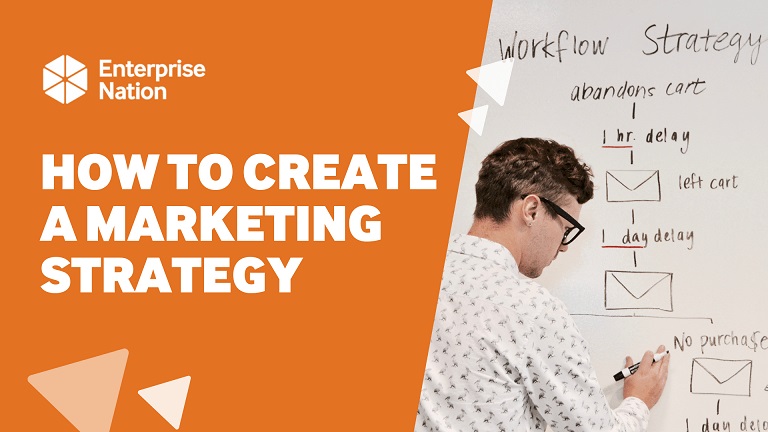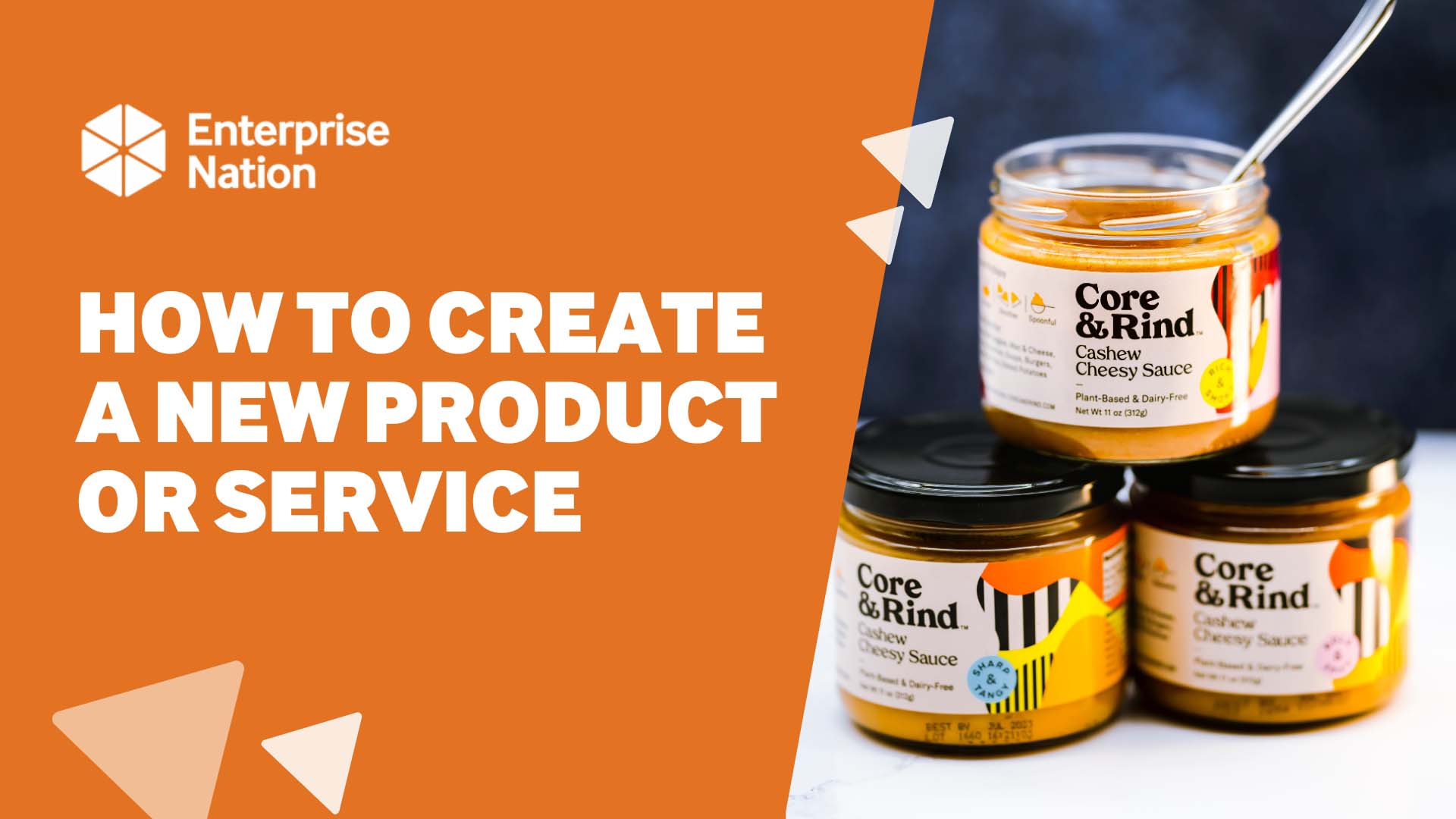How to start a small business in the UK
Why start a small business?
Whether you want to turn a passion into profit, fill a gap in the market or gain control over your career, the small business world is supportive to budding entrepreneurs. But taking the leap does need careful planning, a proper understanding of the business landscape and the ability to navigate the challenges that lie ahead.
The backbone of the UK economy, small businesses account for over 99% of all businesses and employ millions of people.
From busy city centres to rural areas, founders are making products and driving growth in all types of industries – from retail and e-commerce to hospitality, technology and professional services.
In recent years, the UK government has introduced a number of programmes, grants and tax incentives to encourage entrepreneurship.

So many opportunities for new business founders...
Whether you want to set up a local service business or sell your handmade products online, there's a market out there just waiting to be discovered.
The rise in digital technology, and changes in how people shop, have opened doors for creative solutions. If you're ready to put in the work, being a small business can pay off in a big way.
The benefits of running a small business
As your own boss, you can shape your business around your lifestyle – choosing how, when and where you work.
Build something that matters
Besides giving you freedom, having a business lets you create something important, help your community and become financially independent.
Plus, you can follow your interests, make a living and take charge of your career.
For many, it isn't just about the money – but following a dream and leaving a mark.
When you start a business, you join a community of people who drive local economies and bring incredible new ideas to fruition.

Challenges to consider
Despite the significant benefits, starting a small business does come with its share of difficulties. You have to be ready to handle often complicated laws and regulations, financial uncertainty and fierce competition.
Understanding taxes, applying for licences and taking steps to manage the possible risks are just some crucial aspects of running a successful business. There are plenty more!
The competitiveness in many industries and sectors means you must create a business that stands out and can adapt quickly when markets take a turn.
Building a small business calls for hard work, tenacity and a willingness to learn from mistakes. But you can overcome these difficulties with the proper resources, the right support and a good deal of persistence.
Enterprise Nation is always here to help
We've created this hub to be your go-to resource for starting a small business in the UK.
From coming up with a business idea to registering your company, securing funding and eventually growing your venture, here's everything you need to know.
Whether you're a first-time founder or a serial entrepreneur, the information you find here will help you navigate the journey of launching a small business.
Starting a small business: A step-by-step guide
Step 1: Coming up with a business idea
You can't start a small business without the right idea.
A successful business often arises when you can match your skills, passions and experience with a real need in the market.
This section will help you reflect on your unique strengths, identify opportunities in your personal and professional life and turn those insights into a potential business concept.

Why start with your skills, passions and experience?
Starting a business demands commitment, energy and resilience. Choosing an idea that fits with your strengths and interests gives you a better chance of being successful over the long term.
When you're passionate about what you do, it's easier to stay motivated when times get more challenging.
Similarly, building a business around your existing skills or experience means there's less of a learning curve, so you can focus on developing your idea and delivering value to customers.
Reflect on these three key areas:
Skills
What expertise or talents do you have that you could turn into a business?
For example, if you're great at graphic design, you could start a freelancing service or create your own line of products.
Hobbies
What do you enjoy doing in your free time that you could monetise?
Baking, crafting or photography could lead to opportunities in catering, handmade goods or event services.
Work experience
How can your professional background help you create something unique?
For instance, years of experience in marketing might position you to offer consulting services or start a small agency.
Finding skills and interests that can make you money
Think about how your abilities and interests could solve problems or fulfil a need that's going unmet.
Ask yourself:
What do people often ask me for help with?
Have I made something that other people admire or want to buy?
Could I turn my hobbies or talents into a product or service?

Solving problems in your life
Great business ideas often come from personal experience. Reflect on challenges or inconveniences you've faced in your daily life or career. Could you solve these problems for other people?
For example:
If you've struggled to find eco-friendly products to use at home, you might design and make your own.
If you've been at work and found processes that are inefficient, you could create software or tools to address those gaps.
By identifying these "pain points", you position your business as a practical solution. That makes it more likely to resonate with potential customers.

Using your industry experience
This could be your golden ticket! Years of knowledge and insight can help you spot gaps in the market or needs that current businesses are failing to meet.
Here are some examples of how you might put your expertise to work:
Consulting: Share your knowledge with other businesses or people.
Freelancing: Offer specialised skills like marketing, accounting or project management.
Product development: Use your understanding of challenges in your industry to create solutions, such as software tools, educational resources or innovative products.

More support with finding your business idea

How to come up with a business idea: An essential guide
Want to be your own boss and make an impact on the world? Feel like you need something more challenging? That itch to start a business is intoxicating.

Finding the passion to make your business idea happen
Ever wondered what makes someone so passionate about their business that they have the desire and energy to work on it all day, every day?

Lunch and Learn: Where to find ideas for your small business
In this webinar, entrepreneur Grace Castillo discusses where to find business ideas and how to turn them into real, thriving enterprises.
What's next?
Once you've assessed your skills, passions and experience, you'll have the foundation for a strong business idea. The next step is evaluating that idea to make sure it meets market demand, aligns with your goals and has the potential to succeed.
We cover this process in Step 2.
Step 2: Evaluating your business idea
Identified an idea that you think has potential? That's a great start!
Your next step is to assess whether it is viable and meeting a need in the market.
To do this, you must understand the demand for your product or service, analyse the competition and test your concept in the real world.
Here's how to refine your idea into a market-ready business opportunity.

How to assess demand for your product or service
Find out whether people are ready to pay for what you're selling by examining these four areas:
Consumer trends
Recognise emerging shifts in the market by reading industry reports, looking at what people are saying on social media, and exploring customers' buying behaviour.
Market size
Calculate how many potential customers there are for what you're offering. Is the market contracting, staying roughly the same or growing steadily?
Customer needs
Understand what problems your target market are encountering and how your product or service might solve them.
Industry growth
Investigate which sectors or industries in the UK are expanding. Some possible examples are technology, sustainable goods and digital services.
Market research tools and techniques
There are several methods you can employ to gauge demand in your chosen industry:
Google Trends: See how people's interest in particular terms or subjects has evolved over time.
Statista and IBISWorld: Access in-depth market statistics and industry research with a UK focus.
GOV.UK business statistics: The government often publishes reports on business growth trends in the UK. You can find many of these on its website, GOV.UK.
Social media and online communities: Websites like Reddit, Facebook Groups and LinkedIn are a great source of useful data on consumer issues and demands.
Customer surveys and interviews: Use the likes of SurveyMonkey, Google Forms or in-person interactions to gather direct feedback from potential customers.

Analysing your competitors
You can only be confident your business has a good chance of success when you know who you're up against. This means doing a competitor analysis. Here's how:
Determine who your rivals are: Look for businesses that provide goods or services similar to yours. Examine Google, social media, trade publications and online marketplaces such as Etsy or Amazon.
Evaluate their products: What do they cost? Who are they aimed at? What features do they have? How is your competitor advertising them?
Assess their strengths and weaknesses: What does your competitor excel at? Where do they fall short? Use customer reviews and feedback to find any gaps.
Identify your edge: Work out how you can set your business apart – whether it's by offering better customer service or prices, having special features or focusing on an under-represented market.
Let's say you want to launch a line of eco-friendly skincare products. By researching smaller eco-friendly brands and bigger competitors like The Body Shop, you can find ways to stand apart from the competition.

Conducting a feasibility study
How do you know whether your business idea is viable, potentially profitable and likely to sustain itself long term?
By carrying out a feasibility study. This helps make sure you aren't ploughing money into a venture that has little prospect of success.
SWOT analysis (Strengths, Weaknesses, Opportunities, Threats)
A SWOT analysis evaluates your company from four different angles:
Strengths: What advantages does your company have. (This might be strong branding, low production costs or expert knowledge in a particular area.)
Weaknesses: What obstacles might you encounter? For example, perhaps you'll have to deal with a financial shortfall, face intense competition or simply lack the experience to do well.)
Opportunities: What outside factors – such as rising industry demand, technological breakthroughs or government subsidies – can help your company?
Threats: What hazards could endanger your business? (For instance, you could be at risk from changing regulation, financial recession or a new competitor.)
Financial viability: Calculating expenses and income
For your business to be successful, it must be financially viable. Begin by evaluating the following:
Initial expenses: What will it cost to get your business going (for example, equipment, licensing, website development and marketing)?
Operating costs: What are the recurring expenses (like marketing, rent, salaries and stock)?
Revenue projections: Estimate your expected earnings based on market research and the prices your competitors are charging.
Break-even analysis: Work out how long it will take to start turning a profit and pay back your initial investment.
Sustainability: Is your idea good enough to go the distance?
You need to think well beyond the point you launch the business. Consider these factors:
Scalability: Can your business expand over time without incurring costs it can't manage?
Market longevity: Is your industry stable, growing or prone to becoming obsolete?
Customer retention: What do you plan to do to keep customers coming back?
Potential difficulties: What obstacles (such as problems with suppliers, heightened competition or legal changes) might arise as you grow?
Refining your business idea
Once you're clear that there's a place for your business, you may need to refine your idea to improve its chances of success.

Choosing your niche
Focusing on a particular niche can remove some of the competition and help you target a loyal base of customers.
Ask yourself:
Can I serve a specific audience?
Can I specialise in a unique product or service?
Do I have something that will help my brand stand out?

Pivoting your idea
If you've found weaknesses in your idea, consider pivoting – modifying your idea based on what you've learned.
Here are some ways to do it:
Targeting a different market: If competition is too high in one area, explore others that are underserved.
Altering your product or service: Add features, adjust the price or improve delivery.
Exploring a new business model: Consider different revenue streams, such as subscription services, one-time purchases or digital products.
More support with evaluating your idea

What is small business market research and how do I do it?
Want to know what researching your target market actually involves? This overview covers all of the basics, techniques and benefits.

How to conduct market research for a small business
Figuring out customer challenges is the key to entrepreneurship. Do market research to gauge demand for your product and how you should go to market.

Using a SWOT analysis to research competitors and customers
To create successful marketing campaigns, you need to know and understand your customer. Before you start, read this brief guide.
What's next?
By evaluating your business idea thoroughly, you make sure that it's not only creative and interesting but also market-ready. This step lowers the risk and gives you the best possible chances of success.
With your idea validated, you're ready to move on to Step 3.
Step 3: Business laws and regulations in the UK
Starting a small business means understanding which laws apply to you – and then keeping to them!
If you don't do this, you could end up being fined, taken to court or even forced to close your business down.
This section will guide you through registering your business, paying taxes, getting the necessary licences and securing the right insurance to protect your business.

1. Registering your business
By law, you must register your business before you start trading.
In the UK, there are different ways to structure a business, each with their own advantages, legal responsibilities and implications for paying tax. Which one you choose will determine how you register.
Here are the three business structures you'll most often find in the UK.
Sole trader
The simplest structure, where you run the business as an individual.
You keep all profits (after tax) but are personally liable for debts.
Suitable for freelancers, consultants and small-scale businesses.
Partnership
A business run by two or more people who share responsibility for debts and profits.
Partnerships must register with HM Revenue & Customs (HMRC) but do not need to file with Companies House unless they form a limited liability partnership (LLP).
Limited company (Ltd)
A separate legal entity from its owners, offering limited liability protection.
It must be registered with Companies House, follow corporate governance rules and file financial statements every year.
The registration process for different business structures

Sole traders
Choose a business name. (It must not be offensive or infringe trademarks!)
Register with HMRC for Self Assessment and National Insurance.
Open a business bank account. (This is recommended, as it helps you keep personal and business finances separate.)

Limited companies
Choose a unique company name and check with Companies House that it's available.
Prepare the necessary documents: A memorandum of association (agreed by initial shareholders) and articles of association (rules for running the company).
Register your business online at GOV.UK. (There's a fee.)
Register for corporation tax and PAYE (if you're hiring employees) with HMRC.
What it costs to register a small business

Sole trader
Free to register with HMRC.

Limited company
£12 online registration with Companies House. Extra fees apply for legal support and using an accountant.

Annual filings
Limited companies must file annual accounts and confirmation statements (£13 online, £40 by post).
More support with registering your business

How to register your small business (2025)
Ready to start your own business? Before you tell the world, there are a few bits of important admin you need to take care of.

How to register as a sole trader in the UK
This informative blog looks at what it means to be a sole trader and the process involved when it comes to getting registered.

How to set up a limited company in the UK
You don't need a lawyer or an accountant to help you. Here are some simple tips to get up and running in pain-free fashion.
2. Understanding business taxes
Paying the correct taxes is crucial for running a legal business.
Which taxes apply to you will depend on the business structure you chose when first setting up.
Here's a breakdown of the most common business taxes in the UK.
Income tax
Self-employed sole traders and partnerships
Paid on business profits above the Personal Allowance (£12,570 in 2024/2025). Rates range from 20% to 45%.
Corporation tax
Limited companies
Applies to company profits at 25% (or 19% for small profits under £50,000).
Value added tax (VAT)
Charged on most goods and services if your yearly turnover exceeds £85,000.
The standard VAT rate is 20%, but reduced rates apply to some goods.
National Insurance contributions (NICs)
Required for sole traders, company directors and employees.
Registering for VAT and National Insurance contributions
VAT registration
If your turnover is more than £85,000, register at GOV.UK. You must submit VAT returns every quarter.
National Insurance contributions (NICs)
Sole traders: Pay Class 2 NICs (£3.45/week in 2024) and Class 4 NICs (9% on profits over £12,570).
Limited companies: Pay Employer NICs if hiring staff. Directors must pay Class 1 NICs.

Filing tax returns every year
If you're a sole trader or partnership
File a Self Assessment tax return by 31 January (online) or 31 October (paper).
If you're a limited company
You must file corporation tax returns and annual accounts with HMRC and Companies House. Deadlines vary but are usually nine months after the end of the company's financial year.

More support with paying your business taxes

How to pay Self Assessment tax
Whether you're a freelancer or the owner of a limited company, find out how to pay Self Assessment tax for your business in the UK.

How to submit your tax return with confidence
Submitting your Self Assessment tax return can be scary, but it doesn't need to be. This webinar covers everything you need to know.

Lunch and Learn: Five tips for a smooth tax return
Accountant Yarka Krajickova shares her best tips for doing tax returns in a way that makes the whole process much easier.
3. Getting the necessary licences and permits
In certain industries, you must have specific licences and/or permits to operate according to the law.
If you don't get all the licences you need, you could be fined or made to close the business.
Licences and permits for your industry
Some businesses need special approval before they can start trading. For example:
Food businesses
Restaurants, cafes and catering services must register with their local council and comply with food hygiene regulations.
Retail and alcohol sales
To sell alcohol, you need a premises licence and a personal licence from the local authority.
Childcare services
Nurseries and childminders must register with Ofsted and meet strict safety standards.
Financial and legal services
Businesses offering financial advice, insurance or legal services must be regulated by bodies such as the Financial Conduct Authority (FCA).

How to apply for local authority permits
Local councils handle many business licences, such as:
street trading licences (for market stalls or food trucks)
home-based business permissions (if running a business from a rented home, check with the landlord and council)
planning permissions (if making structural changes to a property for business use).
Visit your local council's website or the government's licensing page at GOV.UK to check if you need any licences.

Health and safety rules
Workplace safety
Employers must follow Health and Safety Executive (HSE) regulations, in areas such as risk assessment, fire safety and employee training.
Public health rules
Food businesses must keep to Food Standards Agency (FSA) regulations.
Employee welfare
If you have staff, you must obey employment laws, including minimum wage, working hours and anti-discrimination legislation.

4. Arranging small business insurance
Business insurance is essential, as it protects you against financial losses, legal claims and unforeseen risks.
Some types of insurance you must have by law, while others offer added security.
Here are the main types of business insurance you should be considering.
Employers' liability insurance (needed by law)
If you hire staff, you must have at least £5 million in coverage.
If you don't arrange this cover, you could receive fines of £2,500 per day.
Public liability insurance (recommended for most businesses)
Covers claims if a customer or third party is injured on your premises.
Essential for businesses that have dealings with the public, such as shops and cafes.
Professional indemnity insurance (needed for some professions)
Protects businesses that offer advice or professional services (for example, consultants, accountants, IT services).
Often mandatory for regulated industries like solicitors and financial advisers.
Product liability insurance
Protects against claims if a product you sell causes injury or damage.
Essential for manufacturers, retailers and e-commerce businesses.
Business interruption insurance
Covers loss of income due to unexpected events like fires, floods or pandemics.
Cyber security insurance
Important for online businesses, as it covers data breaches and cyber attacks.
Choosing the right insurance for your business
Identify what insurance the law says you must have (for example, employers' liability for businesses with staff).
Consider the risks in the industry in which you operate (for example, consultants will opt for professional indemnity, while customer-facing businesses will need public liability).
Compare insurance providers and policies to find the best coverage at a competitive rate.

More support with business insurance

I'm starting a business: What insurance do I need?
A look at some of the key types of insurance, and the businesses they're suited to, so you can make an informed decision when arranging cover.

What types of risks does my small business face?
From pre-start brands gearing up to share their vision to early-stage and growing businesses, here's how to prepare for the types of risks you're likely to come up against.

Insurance for self-employed people
If you're self-employed, any mistake you make – even if it's a relatively minor one – could end up being costly to your business. This blog explains what contractors' insurance is and why you might need it.
What's next?
By making sure your business is keeping to the law from day one, you can operate confidently, avoid penalties and focus on growing your venture.
Now, let's move on to business strategy and creating your business plan.
Step 4: Creating your business plan
A well-crafted business plan is the blueprint for your enterprise.
And it's the roadmap for your journey into entrepreneurship. But it also helps you get funding, guides your day-to-day operations and communicates your vision to investors.
This section explores the purpose and benefits of a business plan, breaks down its key sections and highlights templates and tools you can use to create a strong plan of your own.

Purpose and benefits of a business plan
A business plan isn't just a document – it's a strategic tool that outlines your business's vision and operational strategy.
Here's why a business plan is crucial.
A roadmap to success
Your business plan provides clear direction, setting out your short-term and long-term goals and the steps needed to achieve them.
It's a navigational aid for you and your team (if you have one), keeping everyone working towards the business's overall mission.
Securing funding
Investors and lenders need a detailed business plan to judge whether your idea is viable.
A good plan shows that you understand your market, are making realistic financial estimates and can manage risk.
Whether you're seeking bank loans, angel investment or venture capital, a strong business plan is vital.
Managing operations
By outlining your procedures, supplier relationships and day-to-day activities, a business plan helps make sure your venture runs smoothly.
It's your reference point for making informed decisions and managing resources effectively.
Identifying possible challenges
As you create a business plan, you're identifying and addressing potential obstacles, whether they're financial, operational or market-related.
This proactive approach lets you develop contingency plans and adapt your strategies as needed.
Key sections of a business plan
1. Executive summary
Overview: A concise summary of your business concept, mission and vision. This section should capture the essence of your business and pique the interest of investors, potential partners and other people who have a stake in your venture.
Key points: Highlight the unique selling proposition (USP), market opportunity and the competitive advantage that sets your business apart.
2. Business goals
Short-term and long-term goals: Clearly define what you aim to achieve in the near future and where you see your business in the long run. This could include milestones such as reaching a certain revenue target, expanding product lines or entering new markets.
Measurable objectives: Use specific, measurable, achievable, relevant and time-bound (SMART) objectives to provide a framework for gauging progress and success.
3. Market analysis
Target market: Identify your customers. Paint them clearly by providing information about demographics, preferences and behaviours.
Competitor analysis: Evaluate your competition in the UK market. Look at their strengths and weaknesses, pricing and market positioning to determine how you can set your business apart.
Pricing strategy: Analyse market rates and decide on competitive (yet profitable) pricing for your products or services.
4. Marketing and sales
Marketing plan: Outline your marketing channels (for example, social media, email marketing, SEO, content marketing) and tactics to build brand awareness and attract customers.
Sales strategy: Define your approach to sales, including distribution channels, sales process and how you'll manage customer relationships. Explain how you plan to convert leads into loyal customers.
5. Operational strategy
Daily operations: Say how your business will run from day to day. This includes production processes, service delivery and customer support.
Supplier relationships: Identify key suppliers and their roles, and explain how you plan to manage these relationships to ensure a steady supply of goods or services.
Logistics and distribution: Outline how you'll deliver products or services to customers, including any partnerships or systems you'll put in place.
6. Financial projections
Profit and loss forecast: Estimate your expected income and expenses and say when you expect the business to become profitable.
Break-even analysis: Calculate the point at which your business's revenue will cover its costs and show you understand how many units or services you need to sell to break even.
Cash flow projections: Develop a forecast that highlights the cash coming in and going out of the business, helping you manage your finances effectively and maintain liquidity during lean periods.

More support with business planning

How to write a business plan
A detailed guide taking you through how to create your own business plan, including a step-by-step outline for you to follow.

Writing the operations section of your plan
This key section details your day-to-day operations – what you need to run your business, from the processes to the resources and the finance.

Why you need a business plan and how to write one
This webinar explores the key elements included in any good business plan, and why having such a document matters.
What's next?
A comprehensive business plan is an essential foundation for any small business.
By carefully crafting each part – from your executive summary to detailed financial projections – you set your business on a path towards long-term success.
Now, let's look at how to secure financing for your small business.
Step 5: Securing financing for your small business
One of the most crucial steps when starting a business is getting the funding to do it.
With enough money, you can cover the initial start-up costs then start to finance the marketing and growth that comes later.
This section looks at the various types of funding available to you, how to apply for it, and ways to make sure your financial management and budgeting is as good as it can be.

1. Types of business finance available in the UK
When considering how to fund your small business, it's important to understand the range of funding options available.
Each type of financing comes with its own benefits and challenges.
Self-funding and bootstrapping
Many entrepreneurs start their businesses using personal savings or money from family and friends.
This method – often called "bootstrapping" – lets you maintain full control over your business without running up any debt or diluting your ownership.
Key things to consider
Full control over decision-making
No obligation to pay interest or repay borrowings
Demonstrates commitment, which future investors can find attractive
Government grants
The UK government offers a range of grants and initiatives to support small businesses.
Programmes like Start Up Loans provide funding opportunities for businesses that show innovation or have a lot of potential to grow.
Key things to consider
Grants often don't need to be paid back, meaning there's less financial risk
They often come with access to mentoring and networking opportunities
Being awarded a grant can help validate your business idea in investors' eyes
Business loans and lines of credit
Banks offer business loans that can provide the capital you need to expand, buy equipment or cover ongoing running costs.
To get one, you'll typically need a solid business plan, financial forecasts and a good credit history.
A line of credit offers flexible borrowing, as it allows you to draw funds as you need them and pay interest only on the amount you use.
Key things to consider
Interest rates, repayment terms and fees
The strength of your credit history and what you can provide as collateral (security)
What traditional lenders offer compared to newer challenger banks that can sometimes give you more competitive rates and flexible terms
Angel investors, venture capital and crowdfunding
Angel investors: Wealthy people who invest their own money into promising start-ups in exchange for a stake in the business. They often bring expertise and mentorship.
Venture capital (VC): Firms that invest larger sums in companies they expect to grow and generate significant revenue. In return, they typically seek a stake in the business and may influence strategic decisions.
Crowdfunding: Online platforms that allow you to raise small amounts of money from a large number of people. Crowdfunding can also serve as a marketing tool, helping to build a community around your brand.
Key things to consider
The amount of equity (percentage of ownership) you're willing to part with
The stage your business has reached and the level of risk investors are willing to take
The credibility and appeal of your business concept to a broader audience
2. How to apply for small business loans
Securing a loan can be a good way to finance your business. But the process involves careful preparation and you need to understand what lenders are asking of you.
Typical eligibility criteria for loans
Credit history and financial health
Lenders will assess your personal and business credit history, existing debts and overall financial health.
Business plan and financial projections
A well-documented business plan, including detailed financial forecasts, is essential.
Lenders want to see clear evidence of potential revenue, profitability and the ability to repay the loan.
Collateral
Depending on the type of loan, you may need to offer collateral, such as property or other assets, to secure the financing.

Preparing a loan application
Business plan
Make sure your business plan is detailed and sets out your goals, analysis of the market and strategies for growth.
Financial forecasts
Include profit and loss projections, cash flow statements and a break-even analysis. These documents show how you expect your business to perform financially.
Supporting documents
Prepare documentation such as personal and business bank statements, tax returns and evidence of collateral (if needed).
Presentation
Be clear and concise in your application. Highlight your unique selling proposition (USP) and how the funding will help you achieve your business goals.

Understanding interest rates, loan terms and repayment plans
Interest rates
Compare rates from different lenders to find the most competitive option. Lower interest rates make borrowing less costly.
Loan terms
Look for flexible repayment periods that fit your business's cash flow. Shorter terms may mean higher monthly payments, while longer terms often lead to you paying more interest.
Repayment plans
Understand the repayment structure – whether it means fixed monthly payments or a schedule that varies. Some loans may offer a grace period before repayments begin, which can be beneficial in your business's early stages.

3. Financial management and budgeting
It's really important that you manage your business finances properly and use the funds you've secured wisely and sustainably.
Managing cash flow and working capital
Cash flow management
Keep a close eye on your cash flow to make sure you can meet daily running costs. Monitoring it regularly helps you identify potential shortfalls before they become critical.
Working capital
This is the money you have to run your daily operations, calculated by subtracting the business's current debts from its assets. Make sure you have enough cash to cover immediate expenses such as rent, salaries and stock.

Setting up a business bank account
Separating finances
Open a dedicated business bank account to keep your personal and business finances separate. This separation makes accounting, filing tax returns and financial management much more straightforward.
Choosing the right bank
Compare business banking options from high-street banks, challenger banks and digital banks to find one that meets your needs in terms of fees, online banking features and customer support.

Software tools for accounting and bookkeeping
Accounting software
Use tools such as Sage, QuickBooks, Xero or FreeAgent to manage your accounts, track expenses and generate financial reports. These tools can automate many accounting tasks and help you stay organised.
Budgeting tools
Use budgeting software or spreadsheets to plan and monitor your financial goals. Effective budgeting helps make sure that you're allocating every pound in a way that supports your business's growth.
Integration
Look for software that integrates with your business bank account and other financial tools for real-time tracking and reporting.

More support with your business finances

How to raise money for your start-up
Have a great business idea but no cash to start it? Find out what funding is available to you, from loans and grants to crowdfunding and angel investment.

An essential guide to cash flow management
Your small business exists to make a profit. And you can't do that unless you understand cash flow management and how to control your finances.

How to apply for small business grants
There are lots of small business grants available if you know where to look. Get tips for finding a small business grant and making a successful application.
What's next?
Now you've deepened your understanding of business finance and how to secure what you need, the next step is to think about branding and marketing your business.
Step 6: Branding and marketing your business
To market your business well, you need good branding, a strong digital presence, clever marketing strategies and great customer service.
This section explains how to build an outstanding brand, establish yourself online, put traditional and digital marketing techniques to good use, and develop customer relationships that will lead to long-term growth.

1. Building your brand
Branding is so crucial to your small business. Why? Because it helps customers remember you, trust you and choose your products or services over those of your competitors.
Here are three reasons why you should take the time to develop your brand.
Establishes trust
A strong brand gives you credibility and builds trust among your target audience, which is crucial for attracting and retaining customers.
Sets you apart
Effective branding makes you different to your competitors by clearly communicating your unique value proposition.
Allows for consistency
Consistent messaging and visual identity reinforce your business's values, making it memorable in your customers' eyes.
Creating a brand identity
Logo and visual elements
Design a memorable logo and choose a cohesive colour palette that reflects your business's personality and appeals to your audience.
Voice and tone
Develop a consistent tone of voice for all your communications, whether it's friendly, professional or innovative. This helps in establishing a clear and relatable brand image.
Brand story
Craft a compelling narrative around your business that highlights your mission, vision and values. A strong story builds emotional connections with your customers.

2. Developing an online presence
Establishing a digital presence through your website, online store and/or social media channels helps more people find, learn about and connect with your brand.
Creating a professional website
Pick a platform
Choose a website platform that suits your needs – WordPress, Wix or Shopify are popular choices for many small businesses.
Design tips
Focus on a clean, responsive design that's easy to navigate. Make sure your site loads quickly and is optimised for mobile devices, as that's how many customers browse now.
Search engine optimisation (SEO) best practice
Optimise your website content with relevant keywords, meta descriptions and high-quality backlinks to improve your search engine rankings and drive organic traffic.

Using social media for business
Choose your platforms
Identify which social media platforms (for example, Facebook, Instagram, LinkedIn, TikTok) best reach your target audience.
Content strategies
Develop a content calendar that includes a mix of promotional posts, industry insights, customer testimonials and engaging visuals to build community and drive engagement.
Consistency and engagement
Maintain a regular posting schedule and actively interact with your followers to build a loyal online community.

Using Google Business Profile and other free digital tools
Google Business Profile
Claim and optimise your Google Business Profile to make your business more visible in local search, provide key information and collect customer reviews.
Other free tools
Make use of free digital tools such as Google Analytics for tracking performance, Canva for creating professional marketing materials and Hootsuite for social media scheduling.

3. Effective marketing strategies for small businesses
A strong marketing strategy combines traditional and digital methods to build presence and expand reach.
By using paid ads, email marketing and networking, your small business can attract new customers, retain existing ones and grow through referrals and measurable results.
Traditional vs. digital marketing
Traditional marketing
Consider local advertising methods like print ads, direct mail and community events. Traditional marketing is effective for building a local presence and reaching audiences that may not be active online.
Digital marketing
Use digital channels – social media, email campaigns and content marketing – to reach a broader audience with targeted messaging and measurable results.
Integrating both methods
A combined approach often yields the best results. Use traditional marketing to establish your brand locally and digital marketing to scale your reach and engagement.
Keen to start marketing your business? Here's where to find support

Paid advertising
Google Ads
Run targeted pay-per-click (PPC) campaigns to reach potential customers who are actively searching for your products or services.
Facebook Ads
Use Facebook's targeting options to display ads to specific demographics based on interests, behaviours and location.
Budget and return on investment (ROI)
Monitor and adjust your advertising spend regularly to get the biggest ROI and make sure your campaigns are working to further your overall marketing goals.

Email marketing for customer retention
Building an email list
Collect email addresses through your website, social media and in-store sign-ups. Offer incentives such as discounts or exclusive content to encourage subscriptions.
Engaging content
Develop personalised email campaigns that include updates, promotions and valuable content to nurture relationships and drive repeat business.
Performance metrics
Track open rates, click-through rates and conversion metrics to refine your email strategy and retain customers in greater numbers.

Networking and word-of-mouth marketing
Local and online networking
Attend industry events, join local business groups and take part in online forums to build relationships and gain referrals.
Encouraging referrals
Introduce referral programmes that reward customers for recommending your business to other people, using the power of word-of-mouth to expand your reach.

4. Customer service and relationship management
Loyalty in customers often comes as a result of providing personalised experiences, rewarding repeat business and acting on feedback.
By listening to customers, resolving their issues quickly and maintaining a strong online reputation, your business can become one that earns trust and leaves people satisfied.
Building customer loyalty
Personalised experiences
Tailor your services and communications to meet individual customers' needs, creating a more personalised experience that encourages them to buy from you again.
Loyalty programmes
Develop rewards programmes or special offers for repeat customers, giving them an incentive to continue choosing your business.

Managing feedback and complaints
Active listening
Regularly seek feedback through surveys, reviews and direct communication. Use this feedback to identify areas for improvement.
Effective resolution
Develop a clear process for addressing complaints swiftly and professionally. Transform negative experiences into opportunities for satisfying existing customers and attracting new ones.

Why reviews and reputation management are important
Collecting reviews
Encourage satisfied customers to leave positive reviews on platforms such as Google, Trustpilot, TripAdvisor and social media. Positive reviews build trust and credibility.
Monitoring reputation
Keep a close eye on online reviews and social media mentions. Respond promptly to both positive and negative feedback to show that you're committed to satisfying customers.
Continuous improvement
Use customer insights to continually refine your products, services and overall customer experience, making sure your business remains competitive and reputable.

More support with branding and marketing

How to build a brand for a small business or start-up
A solid brand is the foundation of any successful start-up. It helps you connect with potential customers and encapsulates your business's personality.

How to create a marketing strategy for your business
Want to take your start-up to the next level? Find out how to use PR, social media, events and more as part of a low-cost marketing strategy.

How to create eye-catching social media content
Learn how to take stunning photos, record captivating videos and write engaging copy for your small business's social media accounts.
What's next?
By employing these marketing strategies, you'll be well on your way to establishing a thriving small business.
Use these insights to refine your approach, connect with your audience and watch your business grow – one customer at a time.
Learn more about growing and managing your business below.
Step 7: Growing and managing your business
Once your small business is up and running, the next crucial phase is growth and making sure you're managing things as well as you can.
This section covers the essential aspects of building a capable team, expanding your operations and monitoring your business's performance to make sure it sees success in the long term.

1. Building your team
A strong team is the backbone of any successful business.
As you grow, you'll need to focus on recruiting the right talent, deciding whether to hire in-house staff or outsource, and developing leadership skills that help you create a positive and productive work environment.
Hiring your first employees
Employment contracts
When recruiting your first staff members, you must draft clear and detailed employment contracts. These should outline roles, responsibilities, salary and working conditions to protect both your business and your new employees.
PAYE system
Registering for the Pay As You Earn (PAYE) system with HM Revenue & Customs (HMRC) is a must when you start employing staff. This system ensures you're deducting income tax and National Insurance contributions correctly from employees' wages.

In-house staff vs outsourcing
In-house staff
For roles that are central to your business's core functions, employing people to work in-house may be more beneficial. These teams can better integrate with your company culture and provide more consistent quality control.
Outsourcing
Think about outsourcing tasks such as accounting, IT support or marketing if you lack the expertise in-house. Outsourcing can give you access to specialised skills without the commitment of hiring full-time employees – and at a price friendly to your budget.
Choosing the right mix
Assess what your business needs and use your budget and long-term goals to determine what balance of in-house and outsourced staff is right for you.

Leadership and managing a team
Developing leadership skills
As your business expands, strong leadership is vital. Invest in training and mentorship programmes that help you and your managers (if you have them) develop effective leadership styles.
Team management
Communicate clearly, set targets you can easily measure and hold regular performance reviews. Encouraging teamwork and developing a positive workplace culture can significantly boost productivity and keep employees happy.

2. Expanding your business
Growth can take many forms – from opening new physical locations to expanding your online presence or introducing more products or services to your range.
Here's how to plan for and manage that expansion effectively.
Opening new locations or expanding online
New physical locations
If you have a bricks-and-mortar business, consider opening other locations to reach new customers. But conduct thorough market research so you're sure each new location is viable.
Expanding online
If your business operates on the internet, boosting your online presence can be a cost-effective way to reach a broader audience. Optimise your website, invest in e-commerce platforms and explore digital marketing strategies to drive online sales.

Diversifying products or services
Broadening your range
Diversification can reduce risk and create new revenue streams. Assess the current market and customer feedback to identify opportunities for new products or services that complement what you offer already.
Innovation
Stay ahead of industry trends and continuously find new and modern ways to meet customers' changing needs. Experiment with limited releases or pilot programmes before rolling out new offerings on a larger scale.

Franchising opportunities
Growing through franchising
Franchising can be an effective way to expand your business quickly while using a franchisee's entrepreneurial drive to your advantage. Develop a strong franchise model that lays out operational standards, training and support.
Legal and financial considerations
Make sure your franchise agreement meets UK regulations and that you have the necessary legal and financial infrastructure to support franchising.

3. Monitoring how your business is performing
Consistently monitoring and analysing your business's performance is crucial if you're going to make informed decisions and steer your company towards long-term success.
Key performance indicators (KPIs) for small businesses
Financial KPIs
Track revenue, profit margins, cash flow and break-even points to gauge your financial health. Set targets that fit with your business goals.
Operational KPIs
Monitor metrics such as customer satisfaction, employee productivity and order fulfilment times to make sure you're running at full efficiency.
Marketing KPIs
Measure your marketing campaigns' performance by looking at website traffic, conversion rates and social media engagement.

Tools for tracking performance
Software
Use accounting and performance management software such as Sage Accounting, QuickBooks, Xero or LivePlan to automate data tracking and generate insightful reports.
Manual methods
In the early stages, simple spreadsheets and regular review meetings can also be effective for monitoring progress. As your business grows, consider introducing more advanced analytics tools.
Regular reviews
Schedule performance reviews every so often to assess your KPIs, identify trends and make data-driven adjustments to your strategies.

More support with business growth

Finding the right people to grow your business
Whether you’re looking for consultants, temp staff or new full-time members, here's how to find the right people to take your business forward.

How to identify skills gaps in your business
Don't let skills gaps hinder your business's progress. Learn effective ways to identify and bridge these gaps, so your team is prepared for what's ahead.

How to create a new product or service
From generating ideas to testing and launching, here's everything you need to know when looking to expand your range of products or services.
What's next?
By focusing on these crucial areas – team building, expansion and performance monitoring – you'll be well equipped to grow and manage your small business successfully.
Embrace these strategies to drive lasting growth and help you build a resilient, future-proof enterprise.
Final thoughts for aspiring entrepreneurs
In this comprehensive guide, we've covered every key step to launching your small business in the UK – from developing and evaluating your business idea to understanding legal requirements, creating a business plan, securing financing and implementing effective marketing strategies.
We've also discussed the importance of:
building a strong brand
expanding your online presence, and
growing and managing your business through strategic hiring, expansion and performance tracking
These steps are designed to equip you with the essential tools and insights you need to navigate the UK's competitive business world successfully.

Now's the time to take action...
Review your business plan, make sure you're doing everything legally and explore the various funding options available to you.
Use the marketing and growth strategies outlined here to build your brand and engage your target audience, and continuously monitor your performance so you know you're on the right track.
Your journey to becoming a thriving entrepreneur UK starts now – seize the opportunity and turn your vision into reality!
